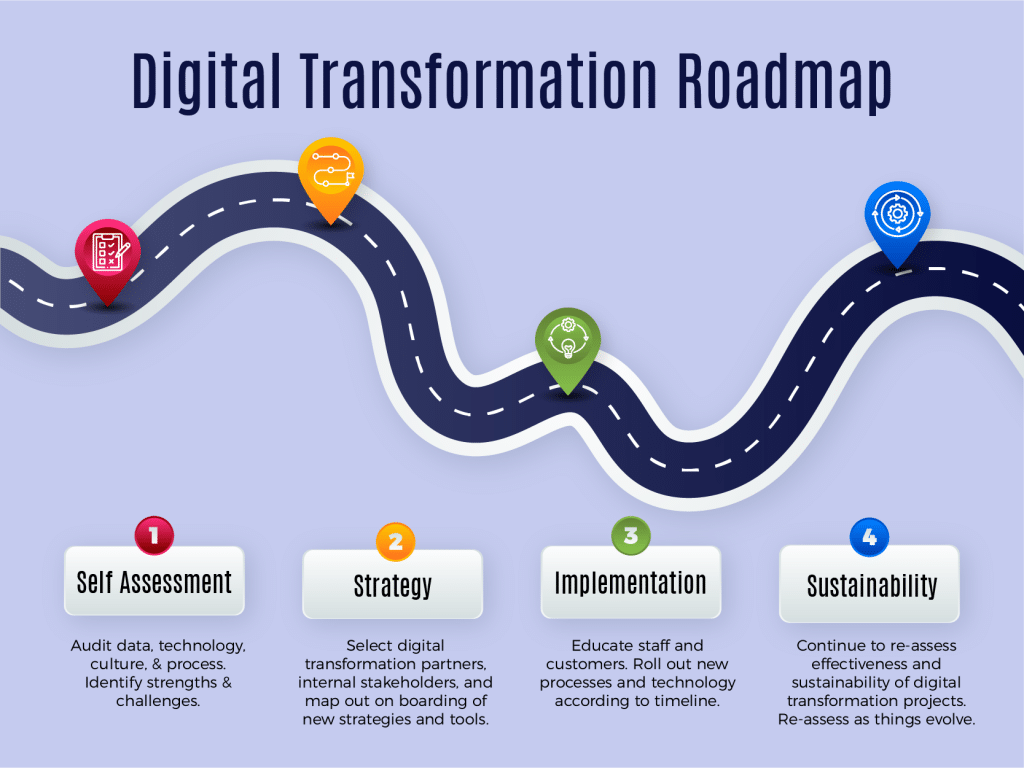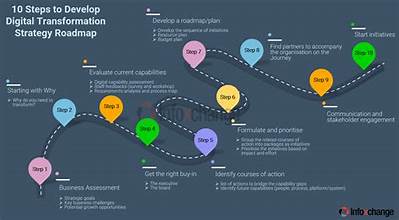Embark on a journey into the world of DigiLife Digital Transformation Roadmap Creation, where innovation and strategy converge to shape the future. Explore the key components, steps, and best practices that drive successful digital transformations in various industries.
Overview of DigiLife Digital Transformation Roadmap Creation

When it comes to digital transformation, having a roadmap is essential for organizations to navigate the complex process of evolving their operations, systems, and strategies to adapt to the digital age.
Creating a digital transformation roadmap involves outlining a detailed plan that guides the organization through the various stages of transformation, from assessing current digital capabilities to implementing new technologies and processes.
Significance of Creating a Roadmap for Digital Transformation
Having a roadmap for digital transformation is crucial as it provides a clear vision and direction for the organization's journey towards becoming more digitally mature. It helps in aligning stakeholders, setting priorities, and ensuring a systematic approach to implementing changes.
- Ensures Alignment: A roadmap helps align different departments and teams within an organization towards common digital transformation goals.
- Sets Priorities: By outlining key milestones and objectives, a roadmap helps prioritize initiatives and investments in digital technologies.
- Manages Risk: Having a structured plan in place allows organizations to anticipate and mitigate potential risks that may arise during the transformation process.
Examples of Industries Benefitting from Digital Transformation Roadmaps
Various industries have leveraged digital transformation roadmaps to drive innovation, enhance customer experiences, and improve operational efficiencies. Some examples include:
- Retail: Retailers have used digital transformation roadmaps to integrate online and offline channels, personalize customer interactions, and optimize supply chain operations.
- Healthcare: Healthcare organizations have adopted digital transformation roadmaps to enhance patient care through telemedicine, electronic health records, and data analytics for personalized treatment.
- Manufacturing: Manufacturers have utilized digital transformation roadmaps to implement smart factories, IoT technologies, and predictive maintenance for optimizing production processes and reducing downtime.
Key Components of a DigiLife Digital Transformation Roadmap

When creating a digital transformation roadmap for DigiLife, it is essential to include specific key components that will guide the process effectively.
Essential Elements in a Digital Transformation Roadmap
Key components that should be included in a DigiLife digital transformation roadmap are:
- Clear Vision and Goals: Define the purpose and objectives of the digital transformation journey.
- Assessment of Current State: Evaluate existing systems, processes, and technologies to identify areas for improvement.
- Technology Integration Plan: Artikel how new technologies will be integrated into the existing infrastructure.
- Change Management Strategy: Develop a plan to manage internal and external stakeholders through the transformation process.
- Timeline and Milestones: Set clear timelines and milestones to track progress and ensure accountability.
Role of Technology in Shaping the Roadmap
Technology plays a crucial role in shaping the digital transformation roadmap for DigiLife by:
- Enabling Innovation: Technology provides the tools and platforms needed to drive innovation and stay ahead of the competition.
- Enhancing Customer Experience: Implementing digital technologies can improve customer interactions and satisfaction.
- Optimizing Operations: Automation and digitization can streamline processes and increase efficiency.
Incorporating Flexibility and Scalability
Flexibility and scalability are important aspects to consider in a digital transformation roadmap:
- Flexible Approach: Allow for adjustments and iterations in the roadmap to adapt to changing business needs and market conditions.
- Scalable Solutions: Implement technologies and strategies that can grow and evolve with the organization's needs over time.
- Continuous Monitoring: Regularly review and assess the roadmap to ensure it remains aligned with the organization's goals and objectives
.
Steps to Develop a DigiLife Digital Transformation Roadmap
.png)
In order to create a successful digital transformation roadmap for DigiLife, it is crucial to follow a structured approach. This involves careful planning, conducting a digital readiness assessment, and setting achievable goals and milestones within the roadmap.
Initial Planning Phase for Creating a Digital Transformation Roadmap
During the initial planning phase, it is essential to define the scope and objectives of the digital transformation roadmap. This involves identifying key stakeholders, setting a clear vision for the transformation, and aligning strategic goals with business objectives.
Conducting a Digital Readiness Assessment
Before embarking on the digital transformation journey, it is important to conduct a thorough digital readiness assessment. This involves evaluating the current state of digital capabilities, resources, and processes within the organization. By identifying strengths, weaknesses, opportunities, and threats, the assessment helps in understanding the readiness of the organization for digital transformation.
Setting Achievable Goals and Milestones Within the Roadmap
Once the planning and assessment phases are complete, the next step is to set achievable goals and milestones within the digital transformation roadmap. These goals should be specific, measurable, achievable, relevant, and time-bound (SMART). By breaking down the transformation journey into smaller, manageable steps, the organization can track progress, stay on course, and celebrate milestones along the way.
Best Practices for Implementing a DigiLife Digital Transformation Roadmap
Effective implementation of a digital transformation roadmap requires careful planning and execution. Here are some best practices to consider:
Strategies for Effective Communication and Stakeholder Engagement
Effective communication is key to ensuring all stakeholders are on the same page throughout the implementation process. Some strategies to consider include:
- Regular updates and progress reports to keep stakeholders informed.
- Clear and concise communication of goals, timelines, and expectations.
- Interactive sessions and workshops to gather feedback and address concerns.
- Utilization of multiple communication channels to reach a diverse audience.
Tips for Monitoring and Evaluating Progress
Monitoring and evaluating the progress of the digital transformation roadmap is crucial for identifying any issues or areas for improvement. Some tips to consider include:
- Establishing key performance indicators (KPIs) to measure success against predefined goals.
- Regular reviews and checkpoints to assess progress and adjust strategies if needed.
- Utilizing data analytics and reporting tools to track performance and make data-driven decisions.
- Incorporating feedback from stakeholders to continuously improve the implementation process.
Successful Case Studies of Digital Transformation Roadmap Implementation
Numerous organizations have successfully implemented digital transformation roadmaps to drive innovation and growth. Some examples include:
- Amazon: Leveraging data analytics and artificial intelligence to enhance customer experiences and streamline operations.
- Netflix: Utilizing personalized recommendations and content delivery algorithms to improve user engagement and retention.
- Starbucks: Implementing mobile payment solutions and digital loyalty programs to enhance the customer experience and drive sales.
- General Electric: Embracing the Industrial Internet of Things (IIoT) to optimize manufacturing processes and improve efficiency.
End of Discussion
In conclusion, the DigiLife Digital Transformation Roadmap Creation offers a roadmap to success in navigating the complexities of digital transformation. By understanding the significance of each component and following best practices, organizations can steer towards a digitally empowered future.
 When it comes to digital transformation, having a roadmap is essential for organizations to navigate the complex process of evolving their operations, systems, and strategies to adapt to the digital age.
Creating a digital transformation roadmap involves outlining a detailed plan that guides the organization through the various stages of transformation, from assessing current digital capabilities to implementing new technologies and processes.
When it comes to digital transformation, having a roadmap is essential for organizations to navigate the complex process of evolving their operations, systems, and strategies to adapt to the digital age.
Creating a digital transformation roadmap involves outlining a detailed plan that guides the organization through the various stages of transformation, from assessing current digital capabilities to implementing new technologies and processes.
 When creating a digital transformation roadmap for DigiLife, it is essential to include specific key components that will guide the process effectively.
When creating a digital transformation roadmap for DigiLife, it is essential to include specific key components that will guide the process effectively.
.png) In order to create a successful digital transformation roadmap for DigiLife, it is crucial to follow a structured approach. This involves careful planning, conducting a digital readiness assessment, and setting achievable goals and milestones within the roadmap.
In order to create a successful digital transformation roadmap for DigiLife, it is crucial to follow a structured approach. This involves careful planning, conducting a digital readiness assessment, and setting achievable goals and milestones within the roadmap.





